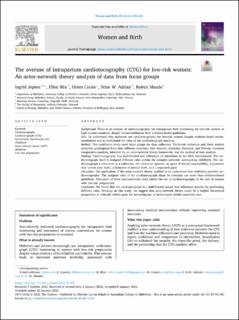| dc.contributor.author | Jepsen, Ingrid | |
| dc.contributor.author | Blix, Ellen | |
| dc.contributor.author | Cooke, Helen | |
| dc.contributor.author | Adrian, Stine Willum | |
| dc.contributor.author | Maude, Robyn | |
| dc.date.accessioned | 2023-01-20T12:31:25Z | |
| dc.date.available | 2023-01-20T12:31:25Z | |
| dc.date.created | 2022-01-25T14:42:16Z | |
| dc.date.issued | 2022-10-31 | |
| dc.identifier.issn | 1871-5192 | |
| dc.identifier.uri | https://hdl.handle.net/11250/3044947 | |
| dc.description.abstract | Background: There is an overuse of cardiotocography for intrapartum fetal monitoring for low-risk women in high-income countries, despite recommendations from evidence-based guidelines.
Aim: To understand why midwives use cardiotocography for low-risk women despite evidence-based recommendations and to understand the roles of the cardiotocograph machine.
Method: This qualitative study used focus groups for data collection. Thirty-one midwives and three student midwives participated from four different countries: New Zealand, Australia, Denmark, and Norway. Constant comparative analysis, informed by an actor-network theory framework, was the method of data analysis.
Findings: Cardiotocography was multifaceted and influenced all attendants in the birth environment. The cardiotocograph itself is assigned different roles within the complex networks surrounding childbirth. The cardiotocograph’s roles were as a babysitter, the midwives’ partner, an agent of shared responsibility, a protector that ‘covers your back’, a disturber of normal birth, and a requested guest.
Discussion: The application of the actor-network theory enabled us to understand how midwives perceive cardiotocography. The assigned roles of the cardiotocograph shape its everyday use more than evidence-based guidelines. Discussion of these inconsistencies must inform the use of cardiotocography in the care of women with low-risk pregnancies.
Conclusion: We found that the cardiotocograph is a multifaceted actant that influences practice by performing different roles. Drawing on this study, we suggest that actor-network theory could be a helpful theoretical perspective to critically reflect upon the increasing use of technologies within maternity care. | en_US |
| dc.language.iso | eng | en_US |
| dc.publisher | Elsevier | en_US |
| dc.relation.ispartofseries | Women and Birth;Volume 35, Issue 6 | |
| dc.relation.uri | https://www.sciencedirect.com/science/article/pii/S1871519222000063?via%3Dihub | |
| dc.rights | Attribution-NonCommercial-NoDerivatives 4.0 Internasjonal | * |
| dc.rights.uri | http://creativecommons.org/licenses/by-nc-nd/4.0/deed.no | * |
| dc.subject | Cardiotocography | en_US |
| dc.subject | CTG | en_US |
| dc.subject | Intermittent auscultation | en_US |
| dc.subject | Childbirth | en_US |
| dc.subject | Actor-network theories | en_US |
| dc.subject | Midwives | en_US |
| dc.subject | Low risk pregnancies | en_US |
| dc.title | The overuse of intrapartum cardiotocography (CTG) for low-risk women: An actor-network theory analysis of data from focus groups | en_US |
| dc.type | Peer reviewed | en_US |
| dc.type | Journal article | en_US |
| dc.description.version | publishedVersion | en_US |
| dc.rights.holder | © 2022 The Authors | en_US |
| cristin.ispublished | false | |
| cristin.fulltext | original | |
| cristin.qualitycode | 1 | |
| dc.identifier.doi | https://doi.org/10.1016/j.wombi.2022.01.003 | |
| dc.identifier.cristin | 1989630 | |
| dc.source.journal | Women and Birth | en_US |
| dc.source.volume | 35 | en_US |
| dc.source.issue | 6 | en_US |
| dc.source.pagenumber | 593-601 | en_US |

